Trams in Budapest
| Trams in Budapest | |||||||||||||
|---|---|---|---|---|---|---|---|---|---|---|---|---|---|
 | |||||||||||||
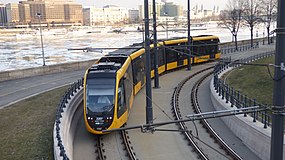 Line 19 tram in Budapest (2017). | |||||||||||||
| Operation | |||||||||||||
| Locale | Budapest, Hungary | ||||||||||||
| Status | Operational | ||||||||||||
| Routes | 36 (26 main, 9 supplemental, 1 cog-wheel railway)[1] | ||||||||||||
| Owner(s) | BKK | ||||||||||||
| Operator(s) | BKV Zrt. | ||||||||||||
| Infrastructure | |||||||||||||
| Track gauge | 1,435 mm (4 ft 8+1⁄2 in) standard gauge | ||||||||||||
| Propulsion system(s) | Electricity | ||||||||||||
| Stock | 610[2] | ||||||||||||
| Statistics | |||||||||||||
| Route length | 174 km (108 mi)[3] | ||||||||||||
| Stops | 630[3] | ||||||||||||
| 2011 | 393.4 million[4] | ||||||||||||
| |||||||||||||
| |||||||||||||
| |||||||||||||
| |||||||||||||
| Website | https://bkk.hu/en/ Budapesti Közlekedési Központ (BKK) (in English) | ||||||||||||
The tram network of Budapest is part of the mass transit system of Budapest, the capital city of Hungary. Tram lines serve as the second-most important backbone of the transit system after the bus network, carrying almost 100 million more passengers annually than the Budapest Metro.[4] In operation since 1866,[5] the Budapest tram network is among the world's largest tram networks by route length—operating on 174 kilometres (108 mi) of total route[3]—and is the busiest in the world.[6][7]
As of 2023, the tram network is made up of 35 regular lines (26 main lines and 9 supplemental lines) and the Budapest Cog-wheel Railway (signed as route 60).[1] The system is operated by Budapesti Közlekedési Zrt. under the supervision of the municipal Budapesti Közlekedési Központ. Since 2016, the system uses the world's longest 9-sectioned articulated tram vehicle, the CAF Urbos 3/9, on route 1.
History
The early days
The first horse-tram line in Budapest was inaugurated on 30 July 1866 between Újpest-Városkapu and Kálvin tér, through Váci út.[5] Over a year before, on 22 May 1865, the Count Sándor Károlyi founded the PKVT (Pesti Közúti Vaspálya Társaság (English: Pest Public Road Rail Tracks Company)).[5] Horse tramlines in Buda proper soon followed, built by the competing Buda Public Road Rail Tracks Company (BKVT).[5]
By 1885, Budapest had as many as 15 horsecar lines,[8] but it had since become obvious that the technology had become obsolete. A steam-driven suburban railway line from Közvágóhíd (Slaughterhouse) to Soroksár, which was run by HÉV, was separately introduced in 1887, and two more lines soon followed.[5]

Around this same time, Mór Balázs suggested that a new, electric tram system should be introduced to Budapest. It was Gábor Baross, then secretary of state at the Ministry of Community Service and Transportation who authorised the construction of the first test tram line between Nyugati railway station[5] and Király utca.[8] Balázs teamed up with Siemens & Halske and Lindheim és Társa and formed a new corporation: BVV (Budapesti Városi Vasút (English: Budapest City Railroad)). The construction works (carried out by Siemens & Halske) started on October 1, 1887 and the line was opened on November 28, 1887. The track gauge of this first line was 1,000 mm (3 ft 3+3⁄8 in) metre gauge and electricity was supplied to the cars from below to avoid cables hanging across the street.[5][9]
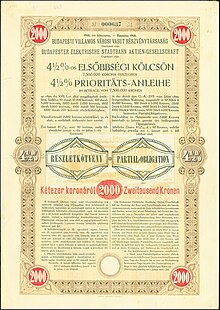
The second step in the expansion of the system were two 1,435 mm (4 ft 8+1⁄2 in) standard gauge lines: on July 20, 1889 the second line, which spanned from Egyetem tér to Fiumei út via Kálvin tér, was opened.[10] It was designed so that in case of a power failure steam engines could tow the carriages. The third line, also standard gauge, was opened on September 10, 1889 and ran from the Hungarian Academy of Sciences to Andrássy út.[11]
Even though not a tram line per se, the first underground line in Continental Europe, the Millennium Underground Railway must also be noted. It was built using a cut-and-cover method between 1894 and 1896 and was first named FJFVV (Ferenc József Földalatti Villamos Vasút (English: Franz Joseph Underground Electric Railway)) after emperor Franz Joseph. It used electric cars from the very beginning.[9]
In the first years, trams had no numbers but coloured circular signals instead, for example, a simple red, green, blue or black disk; a red disk with a vertical white stripe or a cross; a white disk with a green 8-pointed green star, etc. This, of course, quickly became very cumbersome so around 1900, when there were already 30 lines, each line got a number – BVV, which was renamed to BVVV (Budapesti Villamos Városi Vasút (English: Budapest Electric City Railroad)) got the even numbers; odd numbers were assigned to a rival transport company, BKVT (Budapesti Közúti Vaspálya Társaság (English: Budapest Road Rail Company)).[9]
In the last year of the First World War, there were already 1,072 tram trains running in Budapest or on the outskirts of the capital. This fleet carried more than 382 million passengers in Budapest in 1918.[12]
The dynamically growing network brought new companies: two of them served Újpest, the northern part of Pest, one Pestszentlőrinc, which then was a separate town, and one the southern part of Buda and the then-separate village Budafok. These companies were joined together in 1923 by the name BSZKRT (Budapest Székesfővárosi Közlekedési Rt. (English: Budapest Capital Transport Co)). It was during 1939-1944 that the most tram lines (66) existed in the city.[9]
After World War II
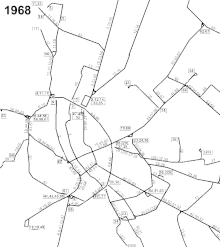
The siege of Budapest left the city with a crippled infrastructure: many houses were destroyed, as well as the bridges bombed, electric cables torn. It was of course of utmost importance to restore the transport network, however, many trams were destroyed either in the siege or in a depot fire that occurred in 1947. This might have been the cause that decisionmakers suggested that trolleybus lines should replace trams in the city centre.[13] Along with cost considerations it is important to note that trolleybuses might be better suited for the downtown area than trams: they turn more easily and produce significantly less noise.
While some tram lines were abolished in favour of trolleybuses, the expansion of the system did not stop. Near Nyugati railway station a new junction of tram lines were built to transport people back and forth to the factories in Angyalföld and Újpest and line 33 through the newly built Árpád Bridge.[14] Line 4 on the Buda side and the tracks on Nagy Lajos király útja were also extended around 1960. The reconstruction of Erzsébet Bridge in 1964 played a significant role in the revival of the tram network: five lines started using it after its opening.[15]
In 1968 there were 83 tram lines in Budapest (10 of which night services) thus reaching the largest extent of the network since World War II,[16] decline was imminent. This happened partly because of the replacement of tram lines with single track and old vehicles with autobuses but also due to the construction of underground lines M2 and M3, which were then thought to be a replacement for the tram lines that used to run above them. In 1972 tram lines on Erzsébet Bridge and Rákóczi út were abolished, then until 1982 tram lines were removed along M3 as well thereby effectively erasing 40 km of rail tracks, around 20% of the Budapest tram network. Along with lines in the city centre, most of the lines in Újpest and some in the southern parts of Pest were demolished.[17]
While many lines were closed down, a significant one was rising: tram 33 was shut down for the renovation of Árpád Bridge in 1981 but when the bridge was reopened, a new line was born on the eastern end of the outer ring road, Hungária körgyűrű, line 1. It has been under construction ever since with segments opened in 1984, 1987, 1990, 1993, 1995, 2000, 2015 and 2019. In 2015 the line crossed to the Buda side of Rákóczi Bridge which was inaugurated in 1995 and was designed for the tram to cross it.[18]
Present and future
As of 2024, it seems that the local governments have shifted towards a more tram-friendly view: line 1 and 3 were renovated [19] and line 1 was extended to Kelenföld vasútállomás.[20] Line 42 is planned to reach the centre of Kispest,[21] and line 47 and 49 are planned to reach Lehel tér, so they can connect into line 12 and line 14, forming a transfer-free connection between Újpest and Budafok.[22] [23]
Lines and developments
As of 2023, it was composed of 35 regular lines (26 main lines and 9 supplemental lines denoted by an 'A' or 'B' after the route number) and the Budapest Cog-wheel Railway. Only route 6 offers 24-hour service, while most other lines run between 5 a.m. and 11 p.m.
| Line | Route | Length (km) | Stations | Ride time (minutes) | Rolling stock | Notes |
|---|---|---|---|---|---|---|
| 1 | Bécsi út / Vörösvári út ↔ Kelenföld vasútállomás |
18.3 | 32 | 52 |
|
|
| 1A | Bécsi út / Vörösvári út ↔ Népliget |
11.2 | 20 | 31 |
|
|
| 2 | Jászai Mari tér ↔ Közvágóhíd |
6.0 | 13 | 20 | Ganz KCSV–7 | |
| 2B | Jászai Mari tér ↔ Pesterzsébet, Pacsirtatelep | 13.9 Southbound
15.0 Northbound |
33 / 35 | 48 / 58 | Ganz KCSV–7 | |
| 3 | Mexikói út |
13.3 | 32 | 51 | CAF Urbos 3, TW 6000 | |
| 4 | Széll Kálmán tér |
8.5 | 19 | 30 | Siemens Combino | |
| 6 | Széll Kálmán tér |
8.3 | 19 | 29 | Siemens Combino | [a] |
| 12 | Angyalföld kocsiszín ↔ Rákospalota, Kossuth utca | 4.7 | 11 | 17 | Tatra T5C5K | |
| 14 | Lehel tér |
11. | 24 | 33 | Tatra T5C5K | |
| 17 | Bécsi út / Vörösvári út ↔ Savoya Park | 14.7 | 37 | 51 |
|
|
| 19 | Bécsi út / Vörösvári út ↔ Kelenföld vasútállomás |
11.2 | 24 | 38 |
|
|
| 23 | Jászai Mari tér ↔ Keleti pályaudvar |
9.4 | 20 | 32 / 34 | Ganz KCSV–7 | [b] |
| 24 | Keleti pályaudvar |
5.2 | 12 | 19 |
|
|
| 28 | Blaha Lujza tér |
10.8 | 26 | 39 |
|
[c] |
| 28A | Blaha Lujza tér |
10.1 | 25 | 37 |
|
|
| 37 | Blaha Lujza tér |
9.7 | 23 | 30 |
|
[d] |
| 37A | Blaha Lujza tér |
5.8 | 14 | 19 | TW 6000 | |
| 41 | Bécsi út / Vörösvári út ↔ Kamaraerdei Ifjúsági Park | 18.4 | 39 | 62 | Tatra T5C5K | |
| 42 | Határ út |
3.0 | 7 | 8–9 |
|
|
| 47 | Deák Ferenc tér |
8.8 | 21 | 31 | Ganz CSMG | |
| 48 | Deák Ferenc tér |
8.0 | 18 | 27 | Ganz CSMG | [e] |
| 49 | Deák Ferenc tér |
5.4 | 12 | 20–21 | Ganz CSMG | |
| 50 | Határ út |
8.0 | 20 | 24–26 | CAF Urbos 3, TW 6000 | |
| 51 | Mester utca / Ferenc körút ↔ Nagysándor József utca | 6.5 / 8 | 15 / 24 | 24 / 30 | TW 6000 | |
| 51A | Mester utca / Ferenc körút ↔ Koppány utca | 2.2 | 8 / 7 | 10-11 | TW 6000 | [f] |
| 52 | Határ út |
6.9 | 17 / 16 | 25 | TW 6000 | |
| 56 | Hűvösvölgy ↔ Városház tér | 16.9 | 37 | 55 | Tatra T5C5K | [g] |
| 56A | Hűvösvölgy ↔ Móricz Zsigmond körtér |
11.2 | 23 | 35 | Tatra T5C5K | |
| 59 | Szent János Kórház ↔ Márton Áron tér | 5.2 | 15 | 19-20 | Tatra T5C5K | |
| 59A | Széll Kálmán tér |
4.1 | 12 | 15-16 | Tatra T5C5K | |
| 59B | Hűvösvölgy ↔ Márton Áron tér | 10.6 | 26 | 34 | Tatra T5C5K | [h] |
| 60 | Városmajor ↔ Széchenyihegy | 3.7 | 7 | 15 | Custom SGP MUs | [i] |
| 61 | Hűvösvölgy ↔ Móricz Zsigmond körtér |
10.9 | 26 | 33-34 | Tatra T5C5K | |
| 62 | Rákospalota, MÁV-telep ↔ Blaha Lujza tér |
13.5 | 33 / 34 | 50-52 | TW 6000 | [j] |
| 62A | Rákospalota, MÁV-telep ↔ Kőbánya alsó vasútállomás (Mázsa tér) | 9.2 | 23 | 34 | TW 6000 | [k] |
| 69 | Mexikói út |
6.5 | 15 | 21-22 | TW 6000 |
Discontinued lines
It is not always straightforward to decide whether a tram line still exists in Budapest since throughout the decades some numbers may have been carried by several lines (not at the same time though), so some numbers might have appeared and disappeared throughout time. Some lines were assigned new numbers so even though there is no line with that specific number, there is a line on exactly the same route. Of course, existing lines might have been lengthened or shortened, so this also makes it hard to exactly define a tram line. Still, the following table tries to summarize these data – termini and dates refer to the last time the number was used.
| Number of the line | Termini | Inauguration and disappearance |
|---|---|---|
| 2A | Jászai Mari tér – Boráros tér H | 1973–2013 |
| 5 | Flórián tér – Hévízi úti lakótelep | 1950–1974 |
| 7 | Óbudai kocsiszín – Margit híd, budai hídfő | 1946–1961 |
| 7i | Fóti út – Rákospalota, Kossuth utca | 1967-1974 |
| 8 | Újpesti piac – Megyeri út | 1955–1980 |
| 9 | Batthyány tér – Budafok, Városház tér | 1920–1986 |
| 9A | Móricz Zsigmond körtér – Albertfalva kitérő | 1961–1972 |
| 10 | Rákospalota, Kossuth utca – Megyeri csárda | 1954–1985 |
| 11 | Margit híd, budai hídfő – Bécsi út | 1950–1981 |
| 13 | Örs vezér tere – Gubacsi út | 1955–2001 |
| 15 | Jászai Mari tér – Újpesti vasúti híd | 1940–1977 |
| 15A | Jászai Mari tér – Váci út | 1963–1977 |
| 18 | Széll Kálmán tér - Savoya Park | 1949-2016 |
| 20 | Ganz gyár – Ferenc körút | until 1977 |
| 22 | Nagyvásártelep – Boráros tér | 1932–1970 |
| 23 | Baross tér (Festetics György utca) – Ferenc körút | 1928–2000 |
| 23A | Népliget – Közvágóhíd | 1953-1964, 1976-1980 |
| 24G | Keleti pályaudvar – Mester utca / Ferenc körút | 2015–2020 |
| 25 | Állatkert (Budapest Zoo) – Thököly út | 1920–1973 |
| 26 | Rókus kórház – Eskü tér | 1910–1956 |
| 26A | Kőrösi Csoma út – Orczy tér | 1942–1956 |
| 27 | Nagyvárad tér – Keleti Pályaudvar | 1957–1959 |
| 29 | József körút – BNV főberjárat | 1925–1995 |
| 29Y | Baross tér (Festetics György utca) – BNV főberjárat | 1974–1995 |
| 31 | Közvágóhíd – Pacsirtatelep | 1973–1995 |
| 32i | Pesterzsébet, Nagy Sándor utca - Ganz-MÁVAG | 1967–1975 |
| 33 | Nyugati pályaudvar – Óbudai kocsiszín | 1950–1981 |
| 34 | Közvágóhíd – Kálvin tér | 1949–1951 |
| 35 | Pacsirtatelep – Határ út – Pacsirtatelep | 1951-1953 |
| 36 | Keleti pályaudvar – Kápolna tér | 1945–1994 |
| 38 | Rókus kórház – Ferenc József laktanya | 1920–1970 |
| 39 | Keleti pályaudvar – Új köztemető | 1927–1932 |
| 40 | Pestszentimre – Pestszentlőrinc | 1947–1975 |
| 43 | Nagytétény – Móricz Zsigmond körtér | 1963–1972 |
| 44 | Zugló, Rákospatak – Keleti pályaudvar | 1972–1995 |
| 45 | Március 15. tér – Keleti Pályaudvar | 1952–1963 |
| 46 | Petőfi híd, budai hídfő – Déli pályaudvar | 1958–1963 |
| 47B | Kamaraerdei Ifjúsági Park – Deák Ferenc tér | 2016–2020 |
| 48 | Nyugati pályaudvar – Albertfalva kitérő | 1957–1960 |
| 53 | Nyugati pályaudvar – Kispest, határ út | 1950–1963 |
| 56 | Moszkva tér – Hűvösvölgy | 1930–2008 |
| 67 | Keleti pályaudvar – Rákospalota, MÁV telep | 1902–1997 |
Rolling stock
Current fleet[24]
As of 24 June 2021
| Image | Tram type or subtype |
Number of cars | Fleet number | Constructed | Transportation in Budapest |
Depot Allocations | |
|---|---|---|---|---|---|---|---|
| Current | Original | ||||||

|
Ganz, CSMG–1 | 3 | (35) | 1301, 1313, 1318 | 1967–1968 | since 1967 | Baross, Budafok*, Ferencváros, Kelenföld |
| Ganz, CSMG–2 | 27 | (85) | 1342, 1349, 1360, 1363–1366, 1369, 1402, 1404, 1407, 1418–1419, 1427, 1433–1434, 1437–1445, 1448, 1450–1451 | 1970–1972, 1975 | since 1970 | ||
| Ganz, CSMG–3 | 1 | (29) | 1461 | 1977 | since 1977 | Kelenföld | |
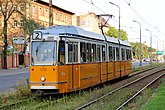
|
Ganz, KCSV–7 | 30 | 1321, 1325–1332, 1335–1337, 1339–1340, 1343–1348, 1350–1356, 1359, 1362, 1370 | 1997–1999 | since 1997 | Ferencváros | |

|
ČKD, Tatra T5C5 | 32 | (322) | 4000, 4014–4015, 4021, 4034–4036, 4044–4045, 4048, 4054–4055, 4154–4155, 4162, 4166–4167, 4171, 4200, 4272, 4277, 4288, 4320, 4322, 4325, 4332, 4335–4336, 4339, 4341, 4346, 4349 | 1978, 1980, 1984 | since 1978 | Angyalföld, Baross, Budafok* |

|
ČKD, Tatra T5C5K Tatra T5C5K2 Tatra T5C5K2M |
288 | 4001–4004, 4005, 4006–4012, 4013, 4016–4020, 4022–4033, 4037–4043, 4046–4047, 4049–4053, 4056–4120, 4122–4153, 4156–4161, 4163–4165, 4168–4170, 4201, 4202–4221, 4223–4271, 4273–4276, 4278–4287, 4289–4319, 4321, 4323–4324, 4326–4331, 4333–4334, 4337–4338, 4340, 4342–4345, 4347–4348 | 2002–2004, 2009– | since 2003 | Szépilona, Angyalföld | |

|
Duewag TW 6000 | 83 | (93) | 1500–1508, 1510–1521, 1523–1524, 1526–1528, 1531–1538, 1540–1564, 1566–1573, 1575–1587, 1589–1590, 1592 | 1975–1978 | since 2001 | Ferencváros, Száva, Zugló |
| LHB TW 6000 | 21 | 1600–1602, 1604, 1606–1607, 1610–1624 | 1980–1982 | since 2012 | Száva | ||
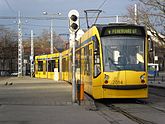
|
Siemens, Combino Supra |
40 | 2001–2040 | 2006–2007 | since 2006 | Hungária | |
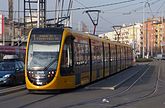
|
CAF Urbos 3 (9-module) |
17 | 2101–2117 | 2015–2016 | since 2016 | Budafok*, Hungária, Száva | |

|
CAF Urbos 3 (5-module) |
56 | 2201–2256 | 2014–2016 | since 2015 | ||
Depots
| Name | Location | Built | Operated vehicle types | Operated lines |
|---|---|---|---|---|
| Angyalföld kocsiszín | Budapest IV., Pozsonyi út 1. | 1896 | Tatra T5C5, Tatra T5C5K2 | 1, 12, 14, 17 |
| Baross kocsiszín | Budapest VIII., Baross utca 132. | 1889 | Tatra T5C5 | 1 |
| Budafok kocsiszín | Budapest XI., Fehérvári út 247. | 1899 | Tatra T5C5, Tatra T5C5K, CAF Urbos 3 | 1, 17, 19, 41, 56 |
| Ferencváros kocsiszín | Budapest IX., Könyves Kálmán körút 7. | 1904 | Ganz CSMG, Ganz KCSV–7, TW 6000 | 2, 24, 28, 28A, 37, 37A, 51, 51A |
| Hungária kocsiszín | Budapest VIII., Törökbecse utca 1. | 1912 | Combino Supra Budapest NF12B, CAF Urbos 3 | 1, 4, 6 |
| Kelenföld kocsiszín | Budapest XI., Bartók Béla út 137. | 1912 | Ganz CSMG | 19, 47, 48, 49 |
| Száva kocsiszín | Budapest IX., Üllői út 197. | 1913 | TW 6000, CAF Urbos 3 | 3, 42, 50, 52 |
| Szépilona kocsiszín | Budapest II., Budakeszi út 9-11. | 1870 | Tatra T5C5K | 56, 56A, 59, 59A, 59B, 61 |
| Zugló kocsiszín | Budapest XIV., Thököly út 173. | 1899 | TW 6000, nostalgia Ganz UVs | 3, 62, 62A, 69 |
Trivia
Budapest won the inaugural European Tramdriver Championship in 2012 and repeated that feat in 2016 and 2024, making the city the record titleholder as of 2024.
See also
- BKV Zrt.
- Budapest Castle Hill Funicular
- Budapest Cog-wheel Railway
- Budapest Metro
- List of town tramway systems in Hungary
References
- ^ a b "Budapesti Közlekedési Központ - Timetables". Budapesti Közlekedési Központ (BKK). Retrieved 2013-10-17.
- ^ "Annual Report 2021" (PDF). BKV Zrt. 2021. p. 18. Retrieved 2023-02-12.
- ^ a b c "Annual Report 2011" (PDF). BKV Zrt. 2011. p. 48. Retrieved 2013-10-06.
- ^ a b "Annual Report 2011" (PDF). BKV Zrt. 2011. p. 4. Retrieved 2013-10-06.
- ^ a b c d e f g "The History of BKV, Part 1 - Development of community transport". BKV Zrt. Retrieved 2013-10-17.
- ^ "Vitézy Dávid: Budapesté a világ legforgalmasabb villamoshálózata". HVG. 15 June 2023. Retrieved 25 December 2023.
- ^ Kéfer, Ádám (15 June 2023). "Budapesté a világ legforgalmasabb villamoshálózata". Index.hu. Retrieved 25 December 2023.
- ^ a b "The History of the Budapest Tram Transport". BKV Zrt. Retrieved 2013-10-17.
- ^ a b c d Legát, Tibor; Zsolt L. Nagy; Gábor Zsigmond (2010). "Bevezető [Introduction]". Számos villamos [Numbered tram] (in Hungarian). Budapest: Jószöveg. pp. 6–12. ISBN 978-615-5009-15-0.
- ^ Legát, Tibor; Zsolt L. Nagy; Gábor Zsigmond (2010). "8". Számos villamos [Numbered tram] (in Hungarian). Budapest: Jószöveg. pp. 57–59. ISBN 978-615-5009-15-0.
- ^ Legát, Tibor; Zsolt L. Nagy; Gábor Zsigmond (2010). "24". Számos villamos [Numbered tram] (in Hungarian). Budapest: Jószöveg. pp. 132–137. ISBN 978-615-5009-15-0.
- ^ BKV: 120 éves a budapesti villamos vasúti közlekedés [1]
- ^ Jakab, László; Zsolt L. Nagy (2011). "Villamospótló". In Legát, Tibor (ed.). Szerbusz trolibusz [Hi there, trolley] (in Hungarian). Budapest: Jószöveg. pp. 46–49. ISBN 978-615-5009-30-3.
- ^ Legát, Tibor (2008). "Harminchárom [Thirty three]". Közlekedik a főváros [The capital in motion] (in Hungarian). Budapest: Jószöveg. p. 38. ISBN 978-963-7052-77-4.
- ^ Legát, Tibor (2008). "Szimbolizmus [Symbolism]". Közlekedik a főváros [The capital in motion] (in Hungarian). Budapest: Jószöveg. p. 52. ISBN 978-963-7052-77-4.
- ^ Gábor Sandi. "Trams of Budapest in 1968". Retrieved 2012-05-18.
- ^ Legát, Tibor (2008). "Halványuló sárga [Fading yellow]". Közlekedik a főváros [The capital in motion] (in Hungarian). Budapest: Jószöveg. pp. 60–62. ISBN 978-963-7052-77-4.
- ^ Legát, Tibor (2008). "A külvárosi gyors [Express in the suburbs]". Közlekedik a főváros [The capital in motion] (in Hungarian). Budapest: Jószöveg. p. 74. ISBN 978-963-7052-77-4.
- ^ Index (2012-05-07). "Bevetik fűvel az 1-es villamos vágányait [Tram line 1 to be seeded with grass]" (in Hungarian). Retrieved 2012-05-18.
- ^ Index (2019-07-09). "Beért az 1-es villamos az Etele térre [Tram 1 has arrived at Etele Square]" (in Hungarian). Retrieved 2019-10-06.
- ^ "Villamossal a Havannára – hamarosan kezdődhet a 42-es villamosvonal meghosszabbításának tervezése". bkk.hu (in Hungarian). Retrieved 2024-04-07.
- ^ Index (2011-11-17). "Budapest: támadnak a villamosok [Budapest: attack of the trams]" (in Hungarian). Retrieved 2012-05-18.
- ^ "Villamossal Újbudától Újpestig – hamarosan elkezdődhet a pesti fonódó villamosprojekt II. ütemének előkészítése és tervezése". bkk.hu (in Hungarian). Retrieved 2024-04-07.
- ^ "Járműállomány (Budapest)". Retrieved 2021-04-02.
External links
- Budapesti Közlekedési Vállalat (BKV) - official site (in Hungarian)
- Budapesti Közlekedési Vállalat (BKV) - official site (in English)
- Budapest network map (including tram lines) (pdf)
- The GS Tram site - Budapest
- Villamosok.hu (in English)
- Trams of Hungary


